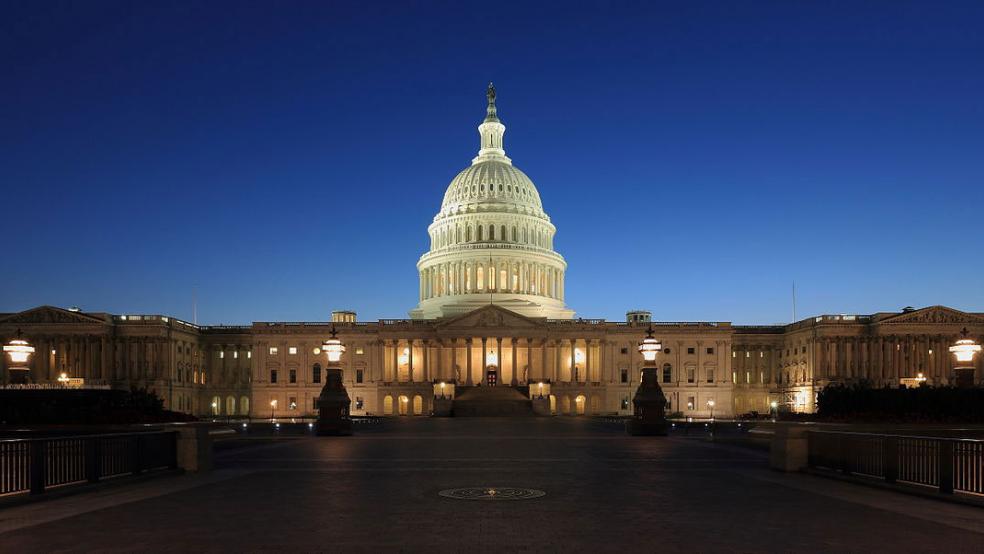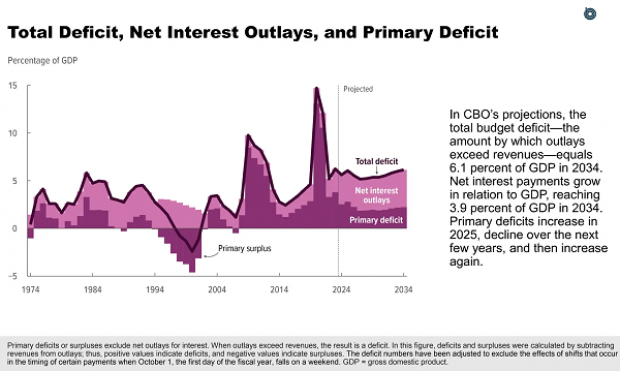The federal government’s $1.6 trillion annual budget deficit will grow significantly larger over the next 10 years, according to the latest outlook from the Congressional Budget Office, released Wednesday. The CBO estimates that deficits will top $2 trillion a year in 2031, rising to $2.6 trillion by 2034 and totaling $19 trillion over the coming decade.
Relative to the size of the economy, the federal budget deficit will equal 5.6% of gross national product in 2024, rising to 6.1% the following year. That represents a level of deficit spending about 50% higher than the post-war norm, and one rarely seen over the last 75 years. “Since the Great Depression, deficits have exceeded that level only during and shortly after World War II, the 2007–2009 financial crisis, and the coronavirus pandemic,” CBO said.
The larger deficits will drive the national debt higher, with debt owned by the public rising from 99% of GDP to 116% of GDP by 3024 — which would be the highest level on record. Total debt owned by the public is projected to top $48 trillion in 2024, up from the current $27 trillion.
Interest costs rising: Interest payments on the national debt are a major part of the deficit, and the growth of those payments accounts for about 75% of the increase in the deficit between 2024 and 2034.
At the start of the 10-year window, interest costs roughly equal discretionary spending on both defense and non-defense activities. But by 2034, interest costs of about $1.6 trillion per year are projected to be about one and a half times bigger than each.
The dynamics of an aging population are also putting upward pressure on deficits, as mandatory spending on retirement and medical benefits in Social Security and Medicare rises.
Some improvement: Thanks to legislation passed by Congress and a surge of immigration, federal budget deficits will be smaller over the next 10 years than previously estimated. Between 2024 and 2033, deficits will be about 7% smaller than projected last year, CBO said, with the economy being about $7 trillion larger and federal revenues $1 trillion higher.
The restraints on the growth of the deficit come from the Fiscal Responsibility Act, which capped spending as part of a deal to raise the debt limit. The FRA reduces spending by about $1.4 trillion over a decade.
“The Fiscal Responsibility Act is the largest deficit-reduction bill in over a decade, and hopefully can be a starting point for further conversation in looking at other parts of the budget and tax code to really change our debt trajectory,” Marc Goldwein, senior vice president at the Committee for a Responsible Federal Budget, a nonpartisan think tank that advocates for smaller deficits, told The Washington Post.
Still, although the latest projections show a reduction in estimated accumulated debt compared to last year, the numbers remain dauntingly large. And it’s worth remembering that CBO projections are based on the assumption that Congress will not cut taxes or adjust spending higher over the next 10 years relative to the current baseline — an assumption that has usually proven to be incorrect.
Budget
Deficits to Soar Over $2 Trillion a Year, CBO Says





